After the introductions, we headed out into the vineyard to meet our adopted vines and better appreciate the diverse terroir of the Alsace wine-growing region. It is after all the starting point for making wine.
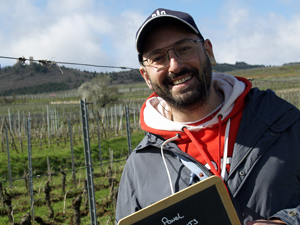
We took some photos with our adopted vines, and listened to Céline as she explained the work of the moment in the vineyard to prune and attach the branches that will produce this year’s fruit-bearing canes. This is probably the most fundamental way in which the winemaker can set the tone for the style of wine that they are trying to produce. Céline pointed out the number of nodes left on each branch and the smaller arc of the vines compared to the majority of the neighbouring vineyard plots. As we could see, Domaine Stentz-Buecher voluntarily reduces the number of fruit-bearing branches that each vine will produce, thus keeping the yield of grapes lower per vine. This ensures grapes of a higher quality, and is one of the main reasons why their wines are more concentrated and aromatic than your average Alsace wine.
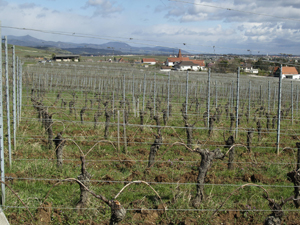
We then followed the journey that the grapes had taken at harvest time back to the winery, where Stéphane explained the different ways that the red and white grapes are received. Some of us had seen this first hand during the Harvest Experience Day last year. The white grapes pass through the press to extract the juice and separate it from the skin, stems and pips, whereas the red grapes are put whole into the vat to extract the colour and tannins from the skin during the maceration phase.
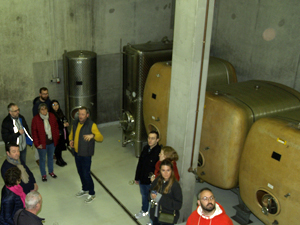
We had a quick look at the barrel room where the pinot noir grapes are aged. Alsace pinot noir is becoming more and more critically acclaimed, and starting with the 2022 vintage, has finally been accepted as one of the grape varietals allowed to be considered for Grand Cru status within the Hengst vineyard.
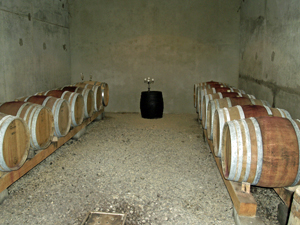
The white wines ferment and are aged in stainless steel vats or large oak casks. Stéphane explained all that happens and how he keeps track of the wines through the fermentation process. He then drew some of the 2022 Pinot Gris Rosenberg directly from the cask for us to taste what a wine is like that hasn’t yet finished. It was still a little cloudy, tingled a little on the tongue, and hadn’t yet developed all of its aromatic potential, but it was great to have the chance to taste a wine at this stage.
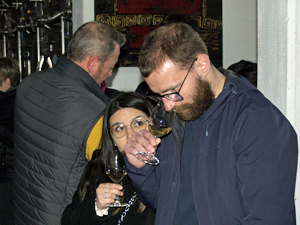
Céline had organised a blind wine tasting session for us. Before starting, we learnt the key steps in wine tasting and how we use all of our senses when doing so. There were three wines in the first series, and our challenge was to describe what we thought of each wine and to name the aromas that we could identify. It’s not always so easy to put words to our sensations! We then tried to determine what the three different wines were. Different grape varietals, different ages ...? Lots of guesses were made, none of them correct! They were in fact all the same grape varietal, riesling. The difference was the type of soil. The first wine was the Riesling Tradition which is made from grapes grown mainly down on the alluvial plain. The next was the Riesling Ortel, from a clay limestone marl soil , and the third wine the Riesling Steingrubler Grand Cru from a sandy clay marl soil on top of limestone and granite . As we had noted, these three different terroirs produce greatly different wines in taste, aroma, and complexity, helping to also explain the different levels of wine in the Alsace hierarchy of AOC wines.
There were two wines in the next series. This time they were of different grape varietals to show the difference between the more floral pinot blanc and the more honeyed and smoky pinot gris.
We continued the wine tasting over lunch of traditional Alsace specialities. Kouglof, choucroute, local cheeses, and black forest gateau, were enjoyed with the 2018 Who Am I blend of pinot blanc, pinot gr is and riesling, the 2019 Gewurztraminer Rosenberg, and the 2019 Pinot Noir Tradition.
After lunch we returned to the cellar to learn about the work for bottling and labelling. Stéphane showed us the filters used to clarify the wines and remove the last of the lees. We learnt the different choices available for corks and their alternatives, and saw the machines used for bottling and labelling.
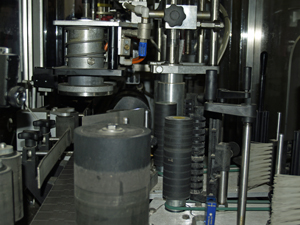
Séphane also explained how the Crémant d’Alsace sparkling wine is made, and he showed us the rotating crate used to collect all of the deposit in the neck of the bottles.
The day finished in the wine library , where a selection of wines are further aged in the bottles before being sold as old vintage wines. It was a very informative day, and we can’t wait to taste our 2022 Pinot Gris Rosenberg wine again when it is ready sometime around the end of the year!
Comments
-
Everything was great. It’s a great concept!





Envoyé le Mercredi 05 April 2023 by Damien et Cindy